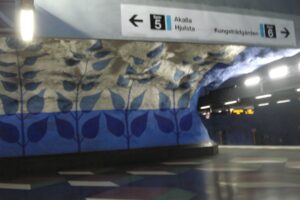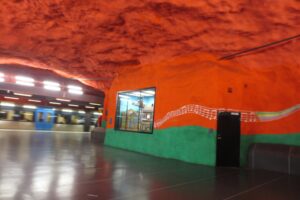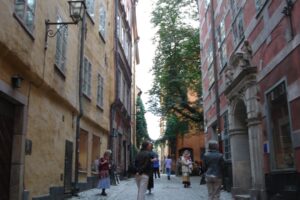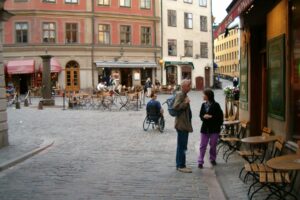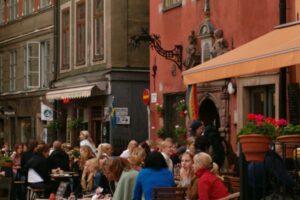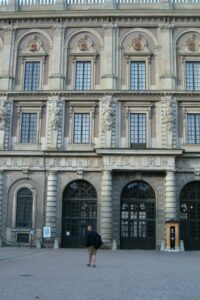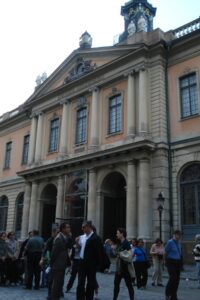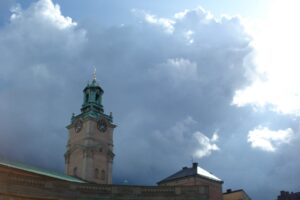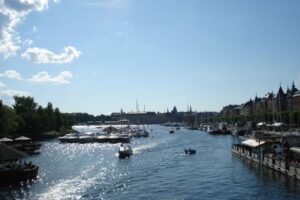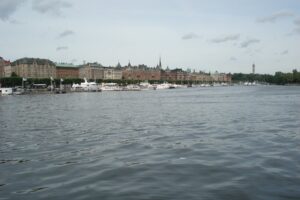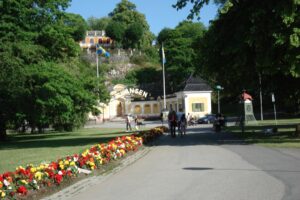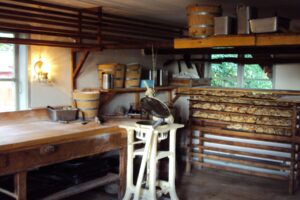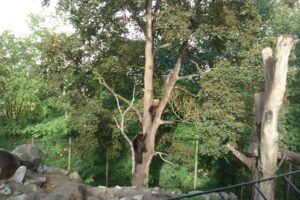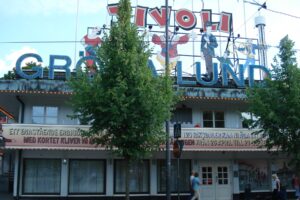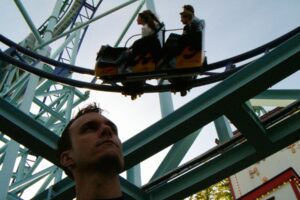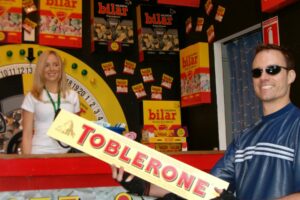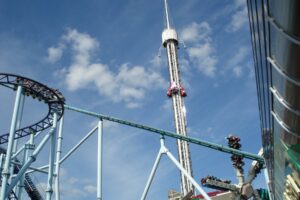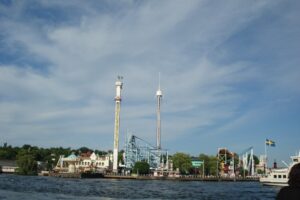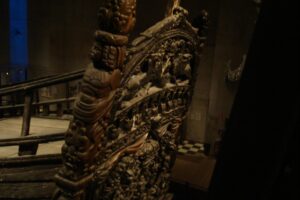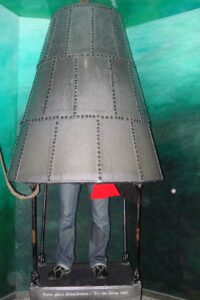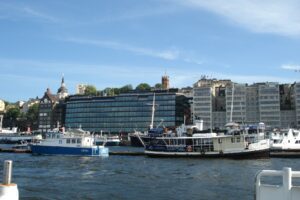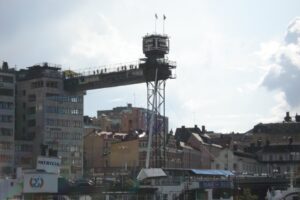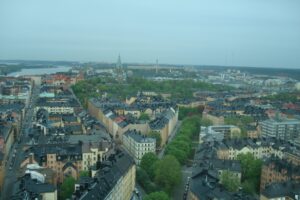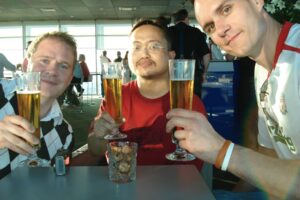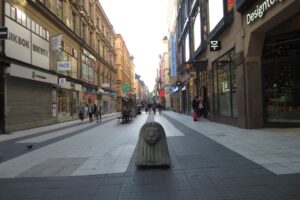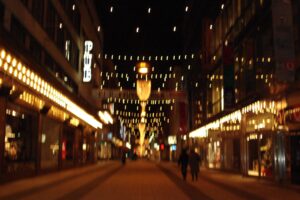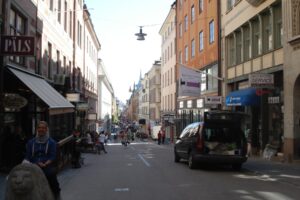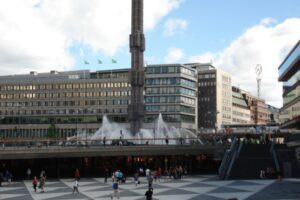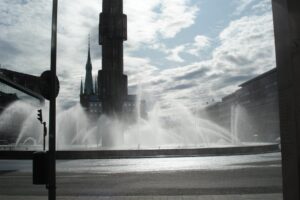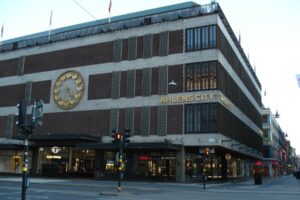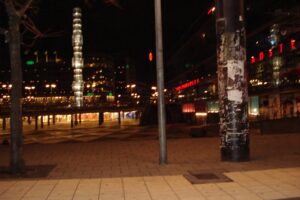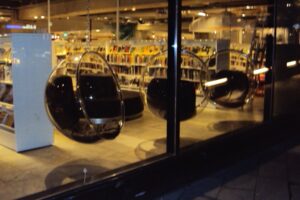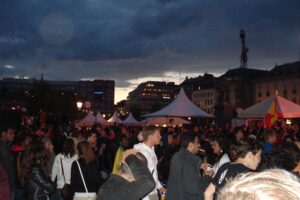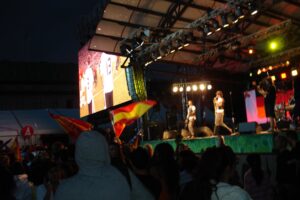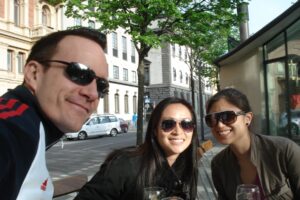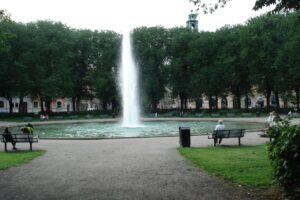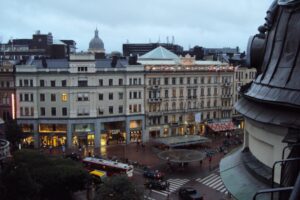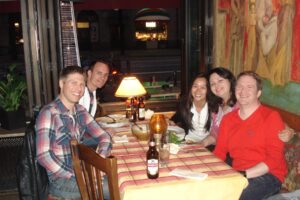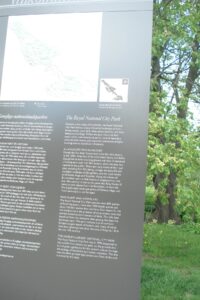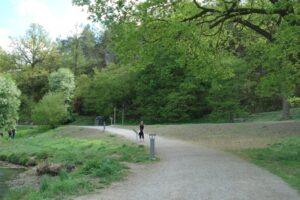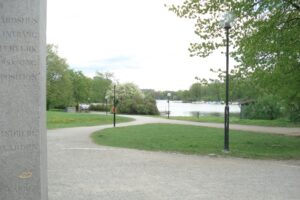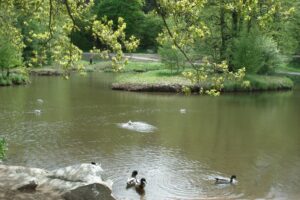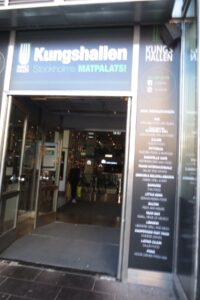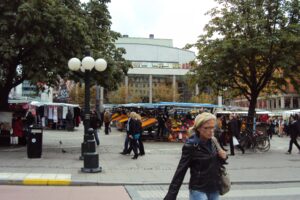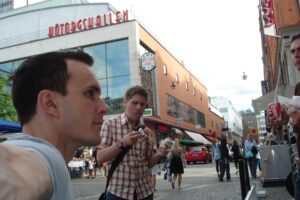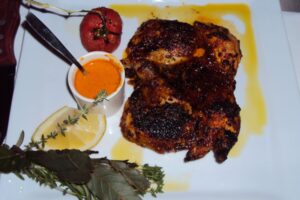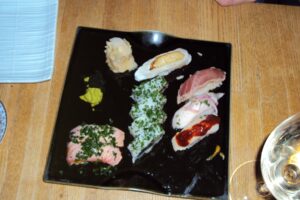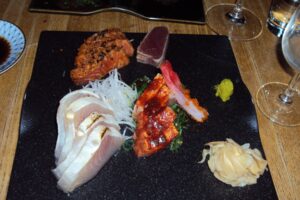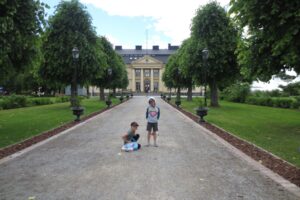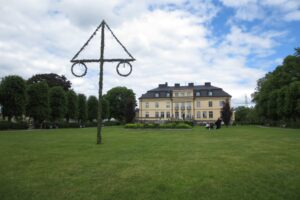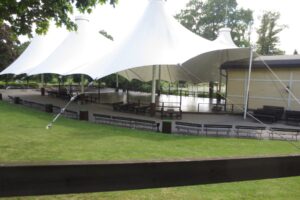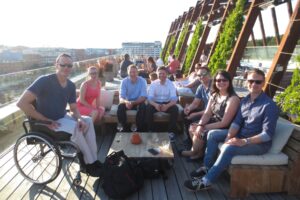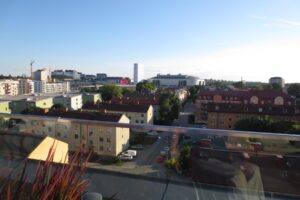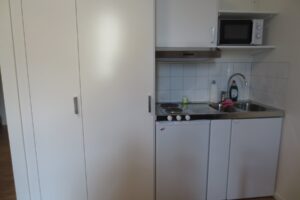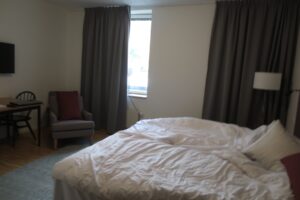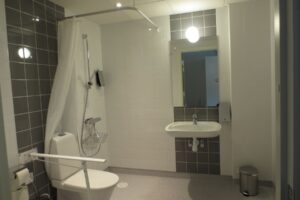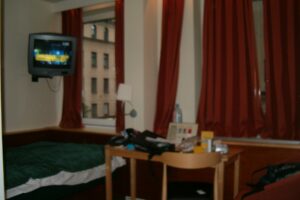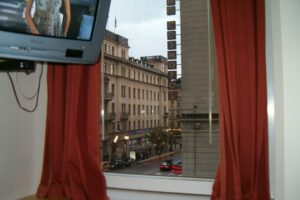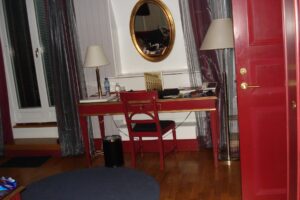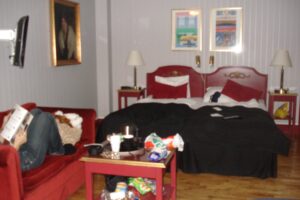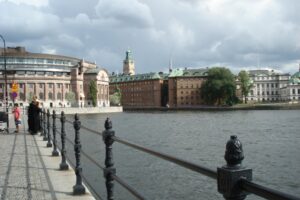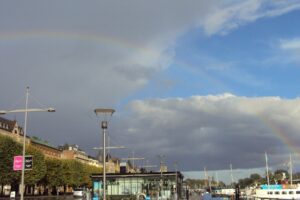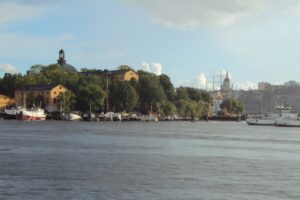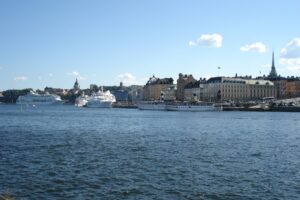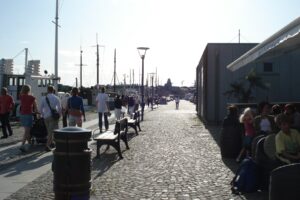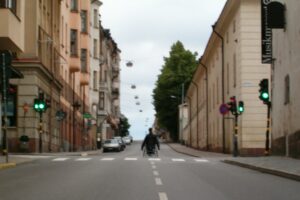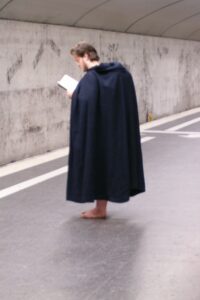The capital and probably the greenest city I’ve ever seen: It’s a series of islands, so you have plenty of water to go with all of the treed avenues and parks! Stockholm is a progressive, cosmopolitan city that has roughly 1 million inhabitants and its rich history has been preserved and proudly put on display. I normally tell people they’ll need about 3 days to check things out and have a good look around (longer, if they’re museum enthusiasts).
Getting around: The high-speed and fully-accessible Arlanda Express train is the fastest way to travel between the airport and central Stockholm (20 mins). There are machines onsite, where you can purchase tickets, or you can get them online ahead of time. Just keep an eye open for deals too, if you’re travelling with somebody on weekends and holidays, as there’s usually a discount for 2 or more passengers.
If you’re staying outside of central Stockholm – particularly in the northern and southern suburbs – a better rail option is the pendeltåg (Commuter Train). It starts north of the airport, in Uppsala, and goes all the way down to Södertälje, with stops in the heart of Stockholm too. The good thing about the pendeltåg is that it’s part of the SL transit network, so if you get a transit card and load it with credits (or purchase a 1, 3, or 7-day pass), it only costs an additional 120 SEK to hop on or off at the airport. Take a look at the location of your hotel and use the trip planner on the SL website to see if this option might be best for you!
Taxis are another option, if you feel like shelling out (fares are more expensive going to the airport, than they are heading into the city, since the airport is remote and the driver is stuck out there – waiting for a return fare). The majority of their cabs are station wagons or vehicles with a large amount of cargo space, so there’s plenty of room for a folding wheelchair and luggage, if you decide to go that route. There are also airport coaches/buses too (Flybussarna), which are the cheapest option (roughly 99 SEK for adults, one way). They take approximately 45 mins to reach the city terminal, but are not equipped with lifts! You have to be able to walk up the stairs, in order to board the bus (the driver will assist you with storing your luggage and mobility device, if you’re able to do so).
Once you’re in the city, you have accessible buses and a fairly-accessible rail system too (i.e. all of the stations are supposed to be accessible, but sometimes you’ll find a bit of a gap between the platform and train in some cases – usually the suburban stations for the commuter train). Personally, I tend to stay centrally and wander around/enjoy the scenery (and exercise!), whenever I visit…and Stockholm is a great ‘walking’ city! 🙂 Most of the main attractions are within close proximity, so if you’re comfortable putting in a few kms/day, you’ll be able to see quite a bit, without ever taking transit.
Tip: If you do plan on taking the subway (aka Tunnelbana or ‘T-bana’), bring your camera! Each station has a unique design and/or artwork, and some are quite elaborate! Also, it might be more cost effective to purchase a SL card (20 SEK) and either load it with credits, or a 1, 3 or 7-day transit pass: Adult fare is 30 SEK and you have a 75 min limit to reach your destination(s), while a 7-day pass costs you 310 SEK. So, if you’re going to be there for awhile and taking transit for the most part, crunch the numbers and see if it’s worthwhile! 🙂 You can buy the travel cards at most train stations and also some Pressbyrån outlets, or use your smart phone instead (at an additional cost). Adding additional credits can be done via the machines at the stations (using your bank/credit card), or with a fare collector, if you’d like to use cash.
- Subway station artwork @ T-Centralen
- Solna Centrum Station
Suggested duration of stay: At least 3 days – even if you’re not a museum-type (add a couple more, if you are)!
What I saw:
Gamla Stan (“The Old Town”) – This section dates back to the 1300’s, so, needless to say, wheelchair access wasn’t really a consideration. The cobblestone roads leading up to The Royal Palace & Stortorget are steep, so it’s best to have somebody with you to help navigate or give you a hand, as the gaps between some of the stones are substantial enough to catch a caster or wheel (or a high heel, for that matter). Definitely worth checking out though, so make sure you ‘eat your wheaties’ and be careful – especially when you’re heading back down those steep roads!
- Stortorget cafés
- CK outside of the Royal Palace (is it just me, or does the guard looks a bit nervous? 😉
- The Swedish Academy – where the Nobel Prize in Literature is awarded (part of the Stock Exchange Building)
- Stockholm Cathedral Clock Tower
Djurgården – A lovely island park and home of the Vasa Museum, Gröna Lund (amusement park), Skansen (partially-accessible, open-air museum that looks at early Swedish settlements & has a small zoo, with native animals), the Nordic Museum, Aquarium, Junibacken (attraction for the kids), and much more. You can also catch a ferry down the road from the amusement park’s main entrance and take it across the harbour to Slussen/Gamla Stan. It’s not a long ride and the view’s great!
- Stockholm from the bridge leading to Djurgården (i.e. the green space on the left)
- Ships parked along Strandvägen, with Djurgården to the right
- Skansen main entrance
- old workshop in Skansen
- Bear habitat at Skansen
Tivoli Gröna Lund – Built in the late 1800’s, it is Sweden’s oldest amusement park and also one of its smallest (given that it’s on an island with no room to expand). It has over 30 rides and also hosts concerts during the summer. Bob Marley still holds the attendance record of 32,000…and I’m guessing the concession stands set sales records too! 😉
- Obscured, but hey…
- I keep hearing a small train pass by…(Me @ Grona Lund 2004)
- Check out what I won!! 🙂 And no, it wasn’t one big Toblerone – there were several mini versions inside
- Gröna Lund – taken from the ferry (which crosses the city harbour to Gamla Stan/Slussen)
The Vasa Museum – Home to ‘The Vasa’ – a warship (69 meters in length) that capsized during its maiden voyage, in 1628. It was raised 333 years later and is the only ship from the 1600’s that’s been preserved and put on display, in the entire world! It’s the most visited museum in Scandinavia and besides being able to see the ship itself, you’re also given a glimpse into what life was like when the ship was being built, and what went into raising and preserving it, in the mid-1900’s.
- Upper deck of the Vasa
- intricate carvings on the back end of The Vasa
- Front end of The Vasa (with some museum patrons in there for scale)
- I think somebody’s using the diving bell…
Södermalm (“SoFo”) – The southern island of central Stockholm – with some of the best views of the city – this trendy area is known for fashion, dining, and vintage shops (considered Bohemian or hipster by some). If you’d like a great 360 degree view of the city, along with a refreshing, adult beverage – check out the restaurant/lounge Och Himlen Dartill.
- Södermalm waterfront – taken from Djurgården-Slussen ferry
- Erik’s Gondola restaurant – Södermalm/Slussen
- Shot of east Sodermalm from Och Himlen Dartill
- Enjoying beverages at Och Himlen Dartill
Drottninggatan – A major pedestrian shopping street – easily identified by the numerous lion statues, shops, and crowds of people, during the day.
- Drottninggatan
- slightly blurry Drottninggatan – after hours, during the holidays
- North end of Drottninggatan
Sergels Torg (aka “Platten”) – The main square – accessible to pedestrians via Drottninggatan. Its towering obelisk, fountains, and sunken pedestrian plaza make it easily recognizable and picture worthy. You can connect to the subway (T-Centralen station), the underground mall (which includes Åhléns City – a multi-level department store that has a grocery store in the basement level, if you’re looking to save on food costs), or you can even walk under the obelisk/fountains and look up through the glass portals, for a cool photo op.
- fountains and obelisk tower
- Åhléns City – with Drottninggatan to the right (notice the time? Yeah, that’s AM and shows how bright it gets in the summer months 🙂
- Sergels Torg – lit up
- Plattan Library
Kungsträdgården (“The King’s Garden”) – is centrally-located and usually has something going on year-round. It’s part plaza, part park – with restaurants, cafes & places to sit/eat/drink, and several points of interest nearby. If you’re looking for something greener and quieter, try nearby Humlegården, or the smaller park-plaza Karlaplan (which has a small market and mall at its north end).
- Kungstradgården during EuroCup 2008
- Enjoying lunch at one of the Kungstradgården cafés
- Karlaplan park
Stureplan – During the day: high-end shopping and restaurants; at night – club district!
Stockholm Stadion – Host of the 1912 Olympic Games, this historic stadium is still in use today for various events and was the home of the Djurgårdens footy team, up until 2013. Worth a look-see, if you’re in the area.
Odenplan – A pedestrian plaza with several small shops and restaurants (Pompei had tasty pizza made in a stone oven & rather interesting décor). Gustaf Vasa Church is here, as is the only self-serve laundromat Tvättomaten (they’re really hard to find and much cheaper than what the hotels charge). There’s 1 big step at the laundromat entrance. Closer to Sveavägen, you’ll find Stockholms Stadsbibliotek (The City Library), which I’ve yet to go into, but pictures reveal that it’s something to see.
- Group pic before dinner at Pompei
- Sorry, you’ll have to look past us to see the decor & pizza oven at Pompei
Hagaparken – Part of Stockholm’s Royal National City Park (along with Djurgården), this huge green space is located in the northern part of the city. It has a lake and great trails for walking/jogging/biking, but is also home to several historic buildings.
Systembolaget – The liquor/beer store for alcohol over 3.5% (anything under that is sold in stores & supermarkets) – they’re easy to spot thanks to their gold and green signs. Interesting fact: This is one of the only Swedish words/terms that’s pronounced exactly how it reads in English (I think that was by design ;)! I also saw some supposedly ‘famous’ Canadian whisky in there that said it’s been around since the 1800’s. I’d never heard of it before and it’s not in any of our liquor stores (pretty sure it’s the stuff that we don’t want – re-branded ;).
Kungshallen – A 3-story food hall, located on Kungsgatan – one block east of Drottningatan and across the road from Hötorget & the Concert Hall. Accessible and offers a wide variety of food, at a cheap to moderate price.
- Kungshallen entrance
- Outdoor market @ Hötorget
Grill – There are several unique restaurants in Stockholm, but many are in historic or re-purposed buildings, so wheelchair access can be hit-or-miss. This restaurant is not only accessible, but has a variety of tasty, grilled foods (on all sections of the menu!) – plus an insanely-varying décor that creates several different themed seating areas, all under 1 roof!
East – Trendy Japanese & Asian-fusion restaurant in Stureplan. Sushi can be served classically or with a modern twist. Pricey, but tasty (and accessible)! True story: It pays to be friendly, or at the very least cordial, as we were fortunate enough to chat with & befriend a businessman, who was dining alone at a neighbouring table. He enjoyed our company so much, that he shared his wine with us and picked up the bill! Talk about Swedish hospitality… 😉
- Modern and classic sushi @ East
Den Gröne Jägaren (“The Green Hunter”) – One of the few remaining pubs that has karaoke nights, but unfortunately, it also has a few steps to get up to the lounge section (where the singing happens) and one big step to get into the bar itself. The staff were happy to accommodate me, so if you’ve got the inclination and don’t mind being bumped up a few stairs, you can get your sing on. 🙂 Washrooms are accessible and are located on the main/street level.
Harry B James – Recently relocated to Kungsträdgården, this restaurant and live music/karaoke venue is almost fully accessible! The only obstacle in the place is one big step up into the stage area (plus steps to get on stage, if you’re looking to karaoke – I just brought the mic stand down from the stage, when I sang). The rest is pretty good and there’s even an accessible bathroom onsite.
Hågelby Park – A park in the southern suburb of Tumba that was converted from a farm, by telephone magnate Lars Magnus Ericsson. It features a classic estate house (with a restaurant and meeting facilities), recreational fields, playgrounds, a small petting zoo, dance/performance area, and a botanical garden. The pathways are mainly dirt or gravel (nothing’s paved), so be ready for a bit of ‘off-roading’.
- path leading to the main estate building
- back of the main building with a Mid-Summer pole
- stage and dance hall
Winery Hotel – Located in Solna, this boutique hotel – with its own winery in Tuscany – has a nice rooftop patio/lounge, with a pool and views of the area (which includes Friends Arena, Haga Park, and Mall of Scandinavia). There’s also a ground-level deli/cafe and delicious restaurant, with an extensive wine list that can be paired with your meal, should you decide to go that route.
- Group shot on the rooftop patio (notice the pool in back, to the right?)
- Friends Area and Mall of Scandinavia in the distance
Where I stayed (year):
Comfort/Clarion Collection Hotel Tapto (2001 & 2004) – a light buffet for all meals and free low-alcohol beer, in the sauna area (at least they used to have that). Good way to cut costs on food and you’re not too far away from the sights (Stadion is a block away). Bathroom doorway had a slight lip to bump over, front door to lobby was manual, and room furniture made it tricky to get to certain parts of the room, but everything else was good (grab bars, etc.). Sauna area even had serve-it-yourself, low-alcohol beer, for free! Rating: 3.75/5
Biz Apt Hotel Solna (2017 – room 406) – Situated in one of Stockholm’s northern suburbs, this property is close to Solna Centrum and has 5 floors of apartment hotels that come equipped with kitchenettes (great for saving money on food and there’s a supermarket next door). It’s about a 5-10 min jaunt uphill from the subway or the tram, but at least the route passes through Skytteholm park – you’ll just have to cross the road to access it, as there isn’t a continuous northbound sidewalk from the hotel! All of the main doors are passkey operated and automatic, but the doorjambs in the hallway leading to the rooms and also the laundry & garbage disposal floors are slightly raised, so be careful. The accessible room is spacious and has fold-down grab bars by the toilet and shower, but the furniture/beds kind of get in the way, if you’re trying to get to the kitchenette or window, so give them a good shove out of the way. Rating: 4/5
Sheraton Stockholm Hotels & Towers (2006, 2008 & 2009) – So close to Stockholm Central Train Station, you can fall over 5 times to get there! It’s centrally located and very close to City Hall, Drottninggatan, and the Parliament Buildings/Gamla Stan. The rooms ending in -51 were considered accessible, but there was a slight lip/bump to get into the bathroom and there weren’t any grab bars (when I last stayed there). I’m hoping this has changed, since their website now has a wheelchair symbol on some room types. Rating: 3.5/5
Comfort Hotel Stockholm (2004) – located RIGHT on top of the Arlanda (Airport) Express/Central Train Station and next door to Kungsgatan and the Ice Bar (in the Nordic C Hotel): The rooms were small and you slept on wall beds that seemed questionable, as to whether or not they were going to hold you, but you can’t beat the location and short walking distance to the train & bus station. There were laundry facilities to use, but not much else in the way of amenities. Rating: 3.5/5
Best Western Premier Hotell Kung Karl (2010) – An historic building, located in Stureplan, wheelchairs have to enter through the restaurant in the back of the building (which means buzzing for security to let you in, after hours). The one accessible room is a superior room, on the top floor – with a widow’s walk (too bad there are steps to get onto it – the view was great)! Everything else in the room was accessible & there’s a breakfast buffet. Rating: 3.5/5
- door to widow’s walk on the left & washroom to the right
- the rest of the room @ Best Western Premier Hotell Kung Karl
Best Western Plus Time Hotel (2012) – It’s a modern hotel with 10 accessible rooms and it’s located just north of Odenplan (with a supermarket next door & breakfast buffet included). It’s a great property, but a couple of kilometers away from the main attractions. Unfortunately (when I went), the adapted rooms were all superior rooms or higher, since those are bigger and have more space, but that also means they typically cost more. I originally booked a standard room online (since they don’t indicate which rooms are accessible) and had to correspond with the manager to get moved to an accessible room, at no additional cost (stating that it was unfair to charge disabled guests more because the property didn’t have the foresight to make 1 or 2 of their standard rooms accessible). Buffet breakfast is included and the restaurant has good access. Rating: 4.25/5
Random Pics:
- Swedish Parliament on the left; Gamla Stan on the right (taken from Drottninggatan bridge)
- Heading towards Djurgården along Strandvagen
- Skeppsholmen with Södermalm in the distance
- places to eat along the waterfront by Strandvagen
- Taken in the wee hours – after the club closed
- Is this how you’re supposed to dress, when riding the subway during Mid-Summer’s?? If it is, I apparently had it all wrong…
